
Messier 83 or M83, also known as the Southern Pinwheel Galaxy and NGC 5236, is a barred spiral galaxy approximately 15 million light-years away in the constellation borders of Hydra and Centaurus. Nicolas-Louis de Lacaille discovered M83 on 17 February 1752 at the Cape of Good Hope. Charles Messier added it to his catalogue of nebulous objects in March 1781.
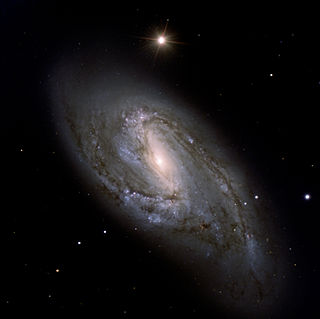
Messier 66 or M66, also known as NGC 3627, is an intermediate spiral galaxy in the southern, equatorial half of Leo. It was discovered by French astronomer Charles Messier on 1 March 1780, who described it as "very long and very faint". This galaxy is a member of a small group of galaxies that includes M65 and NGC 3628, known as the Leo Triplet or the M66 Group. M65 and M66 are a common object for amateur astronomic observation, being separated by only 20′.

Messier 99 or M99, also known as NGC 4254 or St. Catherine's Wheel, is a grand design spiral galaxy in the northern constellation Coma Berenices approximately 15,000,000 parsecs from the Milky Way. It was discovered by Pierre Méchain on 17 March 1781. The discovery was then reported to Charles Messier, who included the object in the Messier Catalogue of comet-like objects. It was one of the first galaxies in which a spiral pattern was seen. This pattern was first identified by Lord Rosse in the spring of 1846.
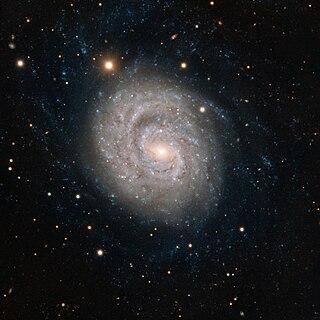
NGC 1637 is an isolated, non-interacting intermediate spiral galaxy in the constellation Eridanus, about a degree to the WNW of the star Mu Eridani. It was discovered by German-British astronomer William Herschel on 1 February 1786. It is located at a distance of about 9.77 ± 1.82 Mpc (31.9 ± 5.9 Mly) from the Milky Way. The galaxy is inclined at an angle of 31.1° to the line of sight from the Earth and the long axis is oriented along a position angle of 16.3°.
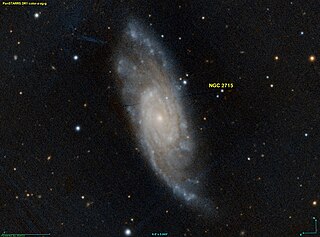
NGC 2715 is an intermediate spiral galaxy in the constellation Camelopardalis. It was discovered in 1871 by Alphonse Borrelly. It is an intermediate spiral galaxy that is 4.9 arcminutes wide.

NGC 4526 is a lenticular galaxy with an embedded dusty disc, located approximately 55 million light-years from the Solar System in the Virgo constellation and discovered on 13 April 1784 by William Herschel. Herschel observed it again on 28 December 1785, resulting in the galaxy being entered twice into the New General Catalogue.

NGC 3054 is an intermediate spiral galaxy in the constellation Hydra. It was discovered by Christian Heinrich Friedrich Peters in 1859. It is probably in the same galaxy group as NGC 2935.
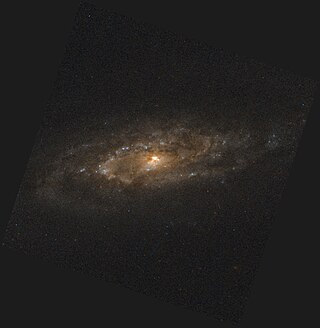
NGC 7537 is a spiral galaxy located in the equatorial constellation of Pisces, about 1.5° to the NNW of Gamma Piscium. It was first documented by German-born astronomer William Herschel on Aug 30, 1785. J. L. E. Dreyer described it as, "very faint, considerably small, round, brighter middle, southwestern of 2". This galaxy lies at a distance of approximately 127 Mly (39 Mpc) from the Milky Way, and is a member of the Pegasus I cluster.

NGC 3344 is a relatively isolated barred spiral galaxy around half the size of the Milky Way located 22.5 million light years away in the constellation Leo Minor. This galaxy belongs to the group known as the Leo spur, which is a branch of the Virgo Supercluster. NGC 3344 has the morphological classification (R)SAB(r)bc, which indicates it is a weakly barred spiral galaxy that exhibits rings and moderate to loosely wound spiral arms. There is both an inner and outer ring, with the prominent arms radiating outward from the inner ring and the slightly elliptical bar being situated inside. At the center of the bar is an HII nucleus with an angular diameter of about 3″. NGC 3344 hosted supernova SN 2012fh, which was shown to likely be a Type Ib or Type Ic.

NGC 935 and IC 1801 are a pair of interacting galaxies within the Aries constellation. They were discovered on 18 September 1885 by Lewis Swift. NGC 935 is the northern member of the pair, and IC 1801 is the southern. Together, they are listed in Halton Arp's Atlas of Peculiar Galaxies as Arp 276, as an example of interacting galaxies.

NGC 5754 is a barred spiral galaxy located 218 million light years away in the constellation Boötes. It was discovered by German-British astronomer William Herschel on 16 May 1787.
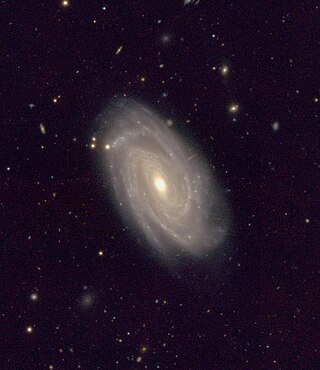
NGC 10 is a spiral galaxy located in the southern constellation of Sculptor. It was discovered by John Herschel on 25 September 1834. The galaxy is located at a distance of 346 Mly from the Sun. Its morphological classification in the De Vaucouleurs system is SAB(rs)bc, where the 'SAB' denotes a weak-barred spiral, '(rs)' indicates a slight ring-like structure, and 'bc' means the spiral arms are moderately to loosely wound. Paturel et al. (2003) assigned this galaxy a classification of SBbc, indicating a barred spiral galaxy.
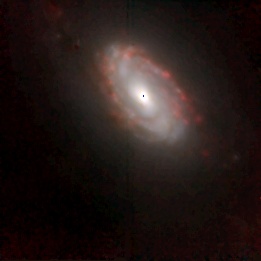
NGC 23 is a spiral galaxy located in the northern constellation of Pegasus, around 173.5 megalight-years distant from the Milky Way. It was discovered by William Herschel on 10 September 1784. In the Webb Society Deep-Sky Observer's Handbook, the visual appearance of NGC 23 is described as follows:
Bright, extended ellipse; a bright nuclear structure is noticeably elongated; two weak spiral enhancements emerge from opposite sides of the nucleus, one curving towards a bright star attached on the south end. The galaxy is likely interacting with NGC 9.

NGC 4666 is a spiral galaxy in the equatorial constellation of Virgo, located at a distance of approximately 55 megalight-years from the Milky Way. It was discovered by the German-born astronomer William Herschel on February 22, 1784. It is a member of the Virgo II Groups, a series of galaxies and galaxy clusters strung out from the southern edge of the Virgo Supercluster. John L. E. Dreyer described it as "bright, very large, much extended 45°±, pretty suddenly brighter middle". It is a member of an interacting system with NGC 4668 and a dwarf galaxy, and belongs to a small group that also includes NGC 4632.

NGC 2397 is a flocculent spiral galaxy located in the southern Volans constellation, about one degree to the SSE of Delta Volantis. English astronomer John Herschel discovered the galaxy on February 21, 1835. It is located at a distance of approximately 69 million light years from the Sun, and is a member of the small NGC 2442 group that includes NGC 2434.

NGC 4866 is an unbarred lenticular galaxy located roughly 100 million light-years away in the constellation Virgo. It was first observed by British astronomer Sir William Herschel on January 14, 1787. It is a member of the Virgo Cluster.

NGC 157 is an intermediate spiral galaxy in the constellation of Cetus, positioned about 4° east of the star Iota Ceti. This galaxy can be viewed from suburban skies using a moderate-sized telescope. It was discovered on December 13, 1783 by William Herschel. The compiler of the New General Catalogue, John Louis Emil Dreyer noted that NGC 157 was "pretty bright, large, extended, between 2 considerably bright stars". It is a relatively isolated galaxy; the nearest other galaxy of comparable luminosity lies at a separation of 4.2 Mly (1.3 Mpc).

NGC 4178 is the New General Catalogue identifier for a barred spiral galaxy in the equatorial constellation of Virgo. It was discovered April 11, 1825 by English astronomer John Herschel. Located some 43.8 million light years away, this galaxy spans 2.3 × 0.4 arc minutes and is seen at a low angle, being inclined by 77° to the line of sight from the Earth. The morphological classification of NGC 4178 is SB(rs)dm, indicating that it has a bar feature at the core, and, per the '(rs)', has traces of a ring-like structure surrounding the bar. The 'dm' suffix indicates the spiral arms are diffuse, broken, and irregular in appearance with no bulge at the nucleus. This galaxy is a member of the Virgo Cluster, which is the richest nearby group of galaxies outside the Local Group and forms the core of the Virgo Supercluster.

NGC 5559 is a barred spiral galaxy, located 240 million light-years away in the constellation of Boötes. It was discovered on April 10, 1785, by the astronomer William Herschel.

NGC 3294 is a spiral galaxy in the constellation Leo Minor. It was discovered by William Herschel on Mar 17, 1787. It is a member of the Leo II Groups, a series of galaxies and galaxy clusters strung out from the right edge of the Virgo Supercluster. The galaxy is located at a distance of 98 million light years and is receding with a heliocentric radial velocity of 1,586 km/s. The morphological class of NGC 3294 is SA(rs)bc, which means this is a spiral galaxy with no central bar (SA), an incomplete inner ring structure (rs), and moderately wound spiral arms (bc).




















